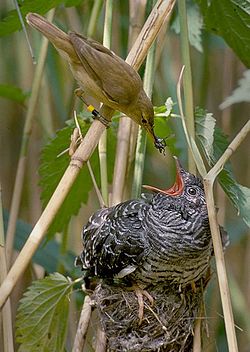| Common reed warbler | |
|---|---|
 | |
| Song recorded in Surrey, England | |
| Scientific classification | |
| Kingdom: | Animalia |
| Phylum: | Chordata |
| Class: | Aves |
| Order: | Passeriformes |
| Family: | Acrocephalidae |
| Genus: | Acrocephalus |
| Species: | A. scirpaceus |
| Binomial name | |
| Acrocephalus scirpaceus (Hermann, 1804) | |
| Subspecies | |
See text | |
 | |
| Distribution Breeding range Resident year-round Passage Non-breeding range | |
The common reed warbler or Eurasian reed-warbler (Acrocephalus scirpaceus) is an Old World warbler in the genus Acrocephalus . It breeds across Europe into the temperate western Palaearctic where it is migratory, wintering in sub-Saharan Africa. It is also a resident species over large parts of Africa.






